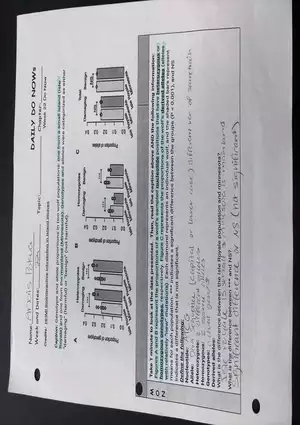Name:
DAILY DO NOWs
Week and Dates:
Topic:
Chapter:
T
Read and HIGHLIGHT the following information regarding the data and answer the question below:
U
In small and isolated populations, individuals have fewer choices for mates. This may lead to inbreeding: producing
E
offspring with a close relative. Inbred offspring may have genetic conditions that reduce their ability to survive and
S
reproduce, which is called inbreeding depression. One example of inbreeding depression is from the gray wolf
population on Isle Royale: a small and isolated island in Lake Superior, off the coast of Minnesota. This population
was started in the 1940s by two or three wolves from the mainland, who crossed the lake when it was temporarily
frozen. Since the Isle Royale population was small (only about 50 wolves max) and almost never had new wolves
from the mainland, inbreeding was common. Many of the inbred offspring had physical conditions that reduced their
survival and reproduction, such as crooked bones, extra bones, and cataracts. By 2018, most of the Isle Royale
wolves had died out.
Why is a low amount of variation in a population considered detrimental?
It may be indicative of inbreeding less genetic diversity
Why might inbreeding cause traits such as crooked bones and cataracts?
Because a inbreeding depression
The original wolves that started the populations on Isle Royale caused a "founder effect" and a "genetic bottleneck".
What might these terms mean?
Group of founders Start 5 Separate population, B a reduction in gene
diversity
W
Read and HIGHLIGHT the following information regarding the data and answer the question below:
What caused inbreeding depression in the Isle Royale wolf population? Two hypotheses are:
1. Inbreeding depression was caused by an increase in the frequency of certain alleles - specifically, derived alleles: alleles
with mutations that are relatively "new" on an evolutionary timescale. An allele was considered derived if it was not found in
the wolves' close evolutionary relatives: the gray fox and the golden wolf.
2, Inbreeding depression was caused by an increase in the frequency of certain genotypes - specifically, damaging
homozygous recessive genctypes: genotypes with two recessive alleles. Since some of these alleles have negative effects,
homozygous recessive genotypes may be "damaging" by causing certain diseases or even death.
With your team choose which hypothesis you concur more and come up with THREE reasons why you prefer
this hypothesis. All teams will be asked to share their choice.
2. IR have a significant amount of humozygous genes
1. The data on alelies isn't significant
3. Hats of heterozigous aneles.
T
Using the data, complete the following statements:
Figure A: The Isle Royale wolves had
less
heterozygous genotypes than the Minnesota wolves.
H
The Isle Royale wolves had more homozygous genotypes than the Minnesota the Minnesota
wolves.
Figure Figure B: C: The Isle Royale wolves did not have significantly more derived alleles than
R
wolves.
S
F
Complete results, inbreeding depression in the Isle Royale wolves is more likely due to (see Wednesday
the following statement:
R
options): Based on these An increase of frequency in the frequency of certain genotupes
I
Provide TWO pieces of evidence from the data to support your choice.
2. 1. NO more significant difference in proportion of alleles
humanigous genotupes
between both populations
$

